The Church and WWII on Guam
The Catholic Church and WWII played significant roles in Guam’s history and cultural evolution. Landmarks and relics from the long role of the church in Guam life and the Japanese invasion and occupation in World War II may be seen all around Guam. The Catholic church was introduced to Guam by the Jesuits in 1668. The United States acquired Guam from Spain in 1898 and administered Guam until the Japanese invasion and occupation, 1941 through 1944. The United States resumed administration of Guam in 1945 with the defeat of Japan. Guam was designated an unincorporated territory of the United States with limited self governing authority in 1951. Today, Guam remains an unincorporated territory of the United States and sends one non-voting Delegate to the US House of Representatives.
The Catholic Church on Guam
Dulce Nombre de Maria. The first Catholic Church on Guam, the Dulce Nombre de Maria (Sweet Name of Mary) Cathedral Basilica, was originally constructed in central Hagatna in 1669-1670 by Chamorro’s under the direction of Padre Diego Luis de San Vitores on lands granted by Chief Quipuha, the ranking male of Hagatna at that time. This structure survived until World War II when it was destroyed during the shelling of Hagatna in preparation for the American invasion. The present church was constructed on the original site in 1955-1959.
Chief Quipuha Park. Quipuha (Kepuha) was the Chief of the area that today is the city of Hagatna when the Jesuits, led by Padre Diego Luis de San Vitores, arrived on Guam in 1668. Chief Quipuha accepted the Catholic religion and was the first Chamorro Chief to permit himself to be baptized. As Chief, or high-ranking male in the Chamorro matriarchal society of the time, Quipuha had the authority to hand down decisions with the advice and consent of the highest ranking woman in his clan. He granted the land on which the first Catholic Church in Guam was constructed in 1669. Chief Quipuha Park and statue in the center of the Hagatna traffic circle on Marine Corps Drive is one of the better known Guam landmarks.
Padre San Vitores. Padre Diego Luis de San Vitores led the Jesuit missionaries who arrived on Guam in 1668 to convert the native Chamorrs to Christianity. In 1672, Padre San Vitores and his Filipino assistant were killed by Chief Mata’pang of TomHom, present day Tumon, for baptizing the Chief’s baby girl at the mother’s request, but without the Chief’s consent. The death of Padre San Vitores lead to all-out war that nearly resulted in extinction of the Chamorro race. San Vitores road in Tumon bears his name and his statue stands in courtyard of the Blessed Diego Luis de Vitores Catholic church located on San Vitores Road.
Padre San Vitores Martyrdom Memorial. This shrine and memorial statue of Padre San Vitores being slain by Chief Mata’Pang is tucked away between Sails Restaurant and the Reef Hotel in Tumon. The site of Vitores martyrdom was listed in the National Register of Historic Places in 1975. The memorial statue was constructed sometime later and the restaurant and hotel constructed around the site obscuring it from the road. To visit the memorial, take the foot path to the beach between the Reef and Sails. Chief Mata’pang’s legacy was not as glorious. He was pursued by the Spaniards and killed on the Island of Rota in 1680. Having been vilified for the incident that sparked the decimation of the pure Chamorro race, the name Mata’pang has evolved to mean, possibly unfairly, someone who foolishly resists progress. The statue represents Padre San Vitores baptizing the Chief’s daughter with the mother and sword wielding Chief standing over them.
Santo Papa as Juan Pablo Dos Monument. This bronze statue of Pope John Paul II (Santo Papa) commemorates the first papal visit to Guam since Christianity was introduced by the Jesuits in the 1668. The statue is located on the spot where the Pontiff conducted mass in the center of Chalan Santo Papa Juan Pablo Dos Street, in Hagatna, between the Plaza De Espana, the U.S. Post Office and the Guam Museum on Skinner Plaza. The statue is motorized and rotates on it’s base at the rate of one revolution every 12 hours. The enormous influence of the Catholic Church on Guam was evidenced by the crowd that showed up for the Pontif’s visit.
Merizo Bell Tower. The Merizo Bell tower (Kampanayum Malesso) is another well-known landmark and evidence of the influence of the Catholic Church on Guam. The tower was constructed in 1910 under the direction of Father Cristobal de Canalas to help raise the standard of living for the people of Merizo village. The tower was constructed with stone and cement. The bell was used to announce religious events, town meetings and mass. Although no longer in use today, it has been maintained and is a well known landmark to visit when in the Southern part of the Island. Merizo (Malesso) is the Southernmost village on the Island of Guam. The village has historically been known as a fishing village and as a destination for treasure hunters. Just off the shore from Merizo lies Cocos Island, known primarily for outings. An an 18th Century Spanish treasure galleon is believed to have sunk off the Southern tip of Cocos Island. Many treasure hunting diving expeditions have pursued this wreck but, as of today, the galleon remains undisturbed.
Guam in World War II
Life and routine were violently curtailed when the Japanese invaded Guam on December 8, 1941, shortly after the attack on Pearl Harbor. The people of Guam suffered greatly under 3 years of Japanese occupation that followed. Over 1,100 Chamorros died and many more suffered atrocities. The battle to liberate Guam lasted for 3 weeks. Approximately 1,800 American servicemen and 18,000 Japanese military were killed. Scores of World War II landmarks and historical sites have been preserved at War in the Pacific National Historic Park – Guam sites across the island. Additional artifacts and interactive exhibits are on display in the NPS Visitor Center and Museum located outside the Naval Base Guam. Be sure to catch the 30 minute movie “Battle of Guam” in the theater and books and educational materials in the gift shop.
Asan Commemorative Monument. This monument Is located on the Asan War in the Pacific National Park, Asan Branch, located on Marine corps Drive, about a mile south of Hagatna. Flanked by the U.S. and Guam flags, the monument sits just off the beach at the actual site where U.S. Third Marine Division landed on July 21, 1944. Also located inside the Asan Division park is a memorial wall with the full list of names of all U.S. Servicemen and civilians who died and suffered on Guam during World War II.
Asan Beach is one of 6 NPS units located at sites across Guam. The Asan unit is located at the site of the Third Marine Division landing on 21 July 1944 during the American invasion to recapture Guam from the Japanese. Other units are Asan Village, Piti, Mount Chacho, Alifan, and Gann Point in Agat. Visitors can still see Japanese coastal defense guns, pillboxes, caves and other relics at various locations across the island. Asan Overlook on Nimitz Hill, offers breathtaking views of the Bay and landing area. The War in the Pacific National Historic Park visitor center and museum is currently located just outside the Naval Base.
Japanese WWII Landmarks
Japanese World II gun emplacements, caves, foxholes and pillboxes as well as sunken ships and airplanes (Japanese and American) are plentiful around Guam and under Guam’s clear waters. The Japanese coastal guns at Gaan point defended one of the two main American landing points in July 1944, the other being Asan. In 1944, the guns and ammunition storage bunker were located in a camouflaged underground bunker and a network of tunnels virtually impregnable by the sea. The Gaan point guns were eventually knocked out by American tanks approaching from the rear.
The large, 65mm, coastal guns at Piti are situated on the hillside in the mountainous jungle. Access is by foot trail behind Our Lady of Assumption Church in Piti. The trail is not easily seen from the road. Park your vehicle in the church parking and you will find the trail behind the church at the jungle’s edge. Take water. It is a bit of a hile up the train o the two separate gun sites. The coastal gun emplacement at Gun Beach can be reached by foot down the beach Northward from the ”The Beach” Bar and Grill. Check out more images of Guam landmarks at Guam-OnLine Image Galleries.
Sunken WWII landing craft and airplanes are popular targets for scuba divers and snorkelers. This Japanese WWII min-submarine was sunk trying to sneak into Apra Harbor at the beginning of the Japanese invasion.  After the war, it was raised and is currently on display at the War in The Pacific National Park Museum just outside the Naval Base Guam main gate. Japanese coastal guns and bunkers still stand in the Guam jungles and on Guam beaches. The Japanese constructed an extensive system of headquarters and ammunition storage tunnels in the Hagatna area using forced Chamorro, Okinawan and Korean labor. The cave entrances pictured here are located in Latte Stone Park in Hagatna.
After the war, it was raised and is currently on display at the War in The Pacific National Park Museum just outside the Naval Base Guam main gate. Japanese coastal guns and bunkers still stand in the Guam jungles and on Guam beaches. The Japanese constructed an extensive system of headquarters and ammunition storage tunnels in the Hagatna area using forced Chamorro, Okinawan and Korean labor. The cave entrances pictured here are located in Latte Stone Park in Hagatna.
War Dog Memorial. The War Dog Memorial, “Always Faithful”, located on Naval Base Guam adjacent to the Sumay marina, honors the Dobermans that served with the Marines during the liberation of Guam in 1944. Twenty-five dogs were killed in action and buried in a small plot at Asan, the main landing point of the American invasion, near the temporary graves of soldiers and Marines. The human bodies were eventually taken back to the US and the dogs were mostly forgotten. In the late 1980’s, William Putney, who had served as the commanding officer of the 3rd War Dog Platoon, lobbied and raised funds for the creation of a memorial to the dogs. A Navy Seabee detachment from NMCB-1 constructed the monument and the remains and markers were moved to a new cemetery on the naval base in June 1994. On July 21, 1994, the 50th anniversary of the American landings for the liberation of Guam, the memorial was dedicated as the first official War Dog cemetery and memorial in the World.
Twenty-five war dogs landed with the 3rd Marine Division on Asan beach on 21 July 1944. The dogs courageously and valiantly performed duties such as leading scouting parties, exploring caves and serving as sentries. One of the dogs, Cappy, is credited with alerting his unit of approaching Japanese saving the unit and the lives of 250 Marines. All 25 dogs were killed during the battle. The sculpture atop the memorial depicts “Kurt”, the 1st war dog to be killed on Guam. The inscription, “Always Faithful”, refers to the Marine Corps’ motto, Semper Fidelis. War dogs continue to serve valiantly with our soldiers and Marines all over the World. Dogs also serve in Homeland Security performing duties such as bomb sniffing, drug detection, law enforcement and in rescue and body recovery operations. For additional reading may we recommend “Always Faithful, A Memior of Marine Dogs of War” by Capt William W. Putney.
Japanese POW Steps.Japanese prisoners of war captured on Guam, Saipan and Rota were held at Naval Base Guam. The prisoners were assigned various masonry and construction duties to keep them occupied. This series of three stone steps located near the old Spanish cemetery and Sumay marina is one of the projects completed by the work that remains in excellent condition today. An inscription in Japanese characters translates as: “In memory of prisoners of war on the island of Rota, on the 27th day of the 7th month in the 21st year of the reign of Emperor Hirohito.” This would be 27 July 1946. At the time of construction, the steps led up to the edge of an area of jungle overgrowth. 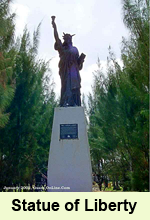 Today, the steps lead to the War Dog memorial which was constructed in 1994.
Today, the steps lead to the War Dog memorial which was constructed in 1994.
This replica of the Statue of Liberty stands in the Paseo de Susana at the entrance to Hagatna Harbor and Boat Basin to welcome arrivals, much the same as the original Statue of Liberty in New York welcomes arrivals to the United States. The statue was donated by the Guam Boy Scouts in 1950 in observance of the 50th anniversary of the Boy Scouts of America.
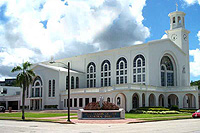 Dulce Nombre de Maria
Dulce Nombre de Maria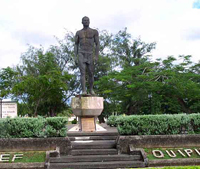 Chief Quiphua Park
Chief Quiphua Park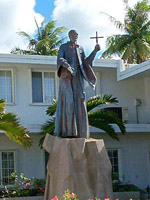 Padre San Vitores
Padre San Vitores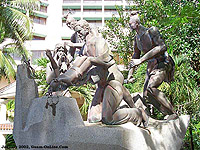 Chief Mata’pang
Chief Mata’pang Monument to Visit
Monument to Visit Merizo Bell Tower
Merizo Bell Tower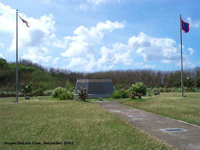 War in the Pacific
War in the Pacific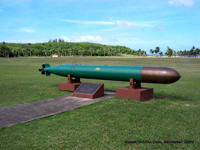 War in the Pacific
War in the Pacific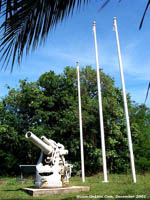 Japanese Coastal
Japanese Coastal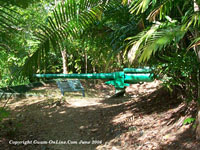 Japanese Coastal Gun
Japanese Coastal Gun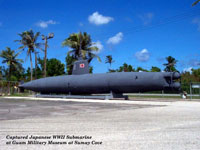 Japanese WWII
Japanese WWII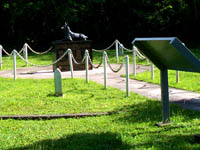 War Dog Memorial
War Dog Memorial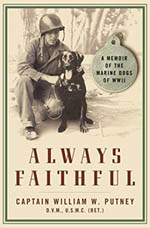 Always Faithful
Always Faithful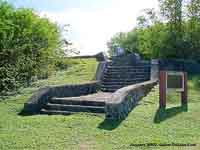 Japanese POW Steps
Japanese POW Steps